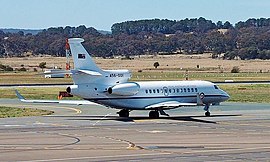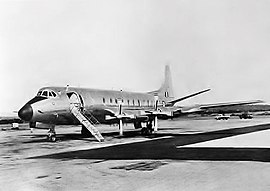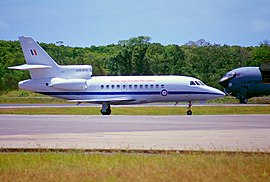No. 34 Squadron RAAF
| No. 34 Squadron RAAF | |
|---|---|
Latin: "I Go and I Return") | |
| Aircraft | Boeing 737 Business Jet Dassault Falcon 7X |
| Engagements | World War II Cold War |
No. 34 Squadron is a
The unit was re-established in March 1948 as No. 34 (Communications) Squadron at
Role and equipment

No. 34 Squadron is the
As at 2011, No. 34 Squadron's strength included around thirty pilots and thirty flight attendants.[6] Captains are generally senior pilots who have previously flown the RAAF's Boeing C-17 Globemaster, Lockheed C-130 Hercules, or Lockheed AP-3C Orion.[7] Their co-pilots are new RAAF personnel who have recently graduated from No. 2 Flying Training School, and the crew attendants are posted to the squadron after completing training and a period of service with No. 33 Squadron.[8] The squadron's VIP Operations Cell (VIPOPS) is responsible for managing requests for VIP air transport as well as dedicated security staff.[8] Most logistical support, including meal preparation, is provided under commercial arrangements rather than by RAAF personnel.[9]

No. 34 Squadron operates two Boeing 737 Business Jets and three Dassault Falcon 7Xs.[1] The aircraft are leased from, and maintained by, Northrop Grumman Integrated Defence Services (previously Qantas Defence Services).[10] The twin-engined Boeing Business Jet (BBJ) is crewed by two pilots and up to four flight attendants, and can carry thirty passengers. The tri-jet Falcon 7X has a crew of two pilots and one flight attendant, and carries up to fourteen passengers.[1] The jets are classified as "Special Purpose Aircraft", meaning that their tasking is governed by Federal guidelines for carrying "entitled persons" on official business. To minimise government outlay, the jets may not be employed when available commercial flights satisfy the timing, location and security requirements of a given task. No. 34 Squadron conducts between 1,200 and 1,800 flights each year. A Schedule of Special Purpose Flights is tabled twice annually in Federal Parliament.[4] VIPOPS usually assigns one of No. 34 Squadron's aircraft to approved tasks, but other Australian Defence Force aircraft are occasionally used for tasks not suited to the BBJ or Challenger; for instance, Prime Minister Julia Gillard travelled to China on board a No. 33 Squadron Airbus KC-30A Multi Role Tanker Transport in April 2013.[11]
History
World War II and aftermath

During February and March 1942, the RAAF formed four transport units: Nos. 33, 34,
No. 34 Squadron was re-formed on 3 January 1943 at Parafield Airport, South Australia, from elements of No. 36 Squadron formerly based at Essendon, Victoria.[5][15] Initially comprising ninety-six personnel and eight aircraft, by the end of the month the squadron's strength had been reduced to seventy personnel and three Dragons operating in South Australia and the Northern Territory. On 11 March one of the Dragons was destroyed on takeoff at Parafield, causing two deaths—No. 34 Squadron's first fatalities. Another Dragon was lost in a fire after it crashlanded near Tennant Creek in April.[5] Beginning in May 1943, the Dragons were augmented by Douglas C-47 Dakotas, giving the squadron a total strength of three Dakotas and two Dragons by the following month.[5][13] By July, No. 34 Squadron was operating five Dakotas, which had fully replaced the Dragons, and in August its strength stood at seven Dakotas and 153 personnel, including forty-seven officers.[5] It subsequently received an Airspeed Oxford and a Douglas DC-2, and began making supply drops and medical evacuations as far north as Port Moresby, New Guinea.[5][13] The squadron had its busiest month in May 1944, transporting almost 1,900 passengers and over 1,000,000 pounds (450,000 kg) of cargo. On 1 June it became the first operational RAAF squadron to have personnel of the Women's Auxiliary Australian Air Force (WAAAF) in its ranks, a contingent made up of an officer and twenty airwomen.[5] The WAAAF had been formed in 1941 and eventually made up thirty-one per cent of RAAF ground staff; its members were primarily employed in technical trades and were not permitted to serve in combat theatres.[16][17]

October 1944 saw a detachment of the squadron operating from
The squadron was re-established at
VIP operations

No. 34 (VIP) Flight was established at RAAF Base Canberra on 12 March 1956, and charged with the safe carriage of the Governor-General, senior Australian politicians and military officers, and visiting foreign dignitaries. It was formed from the VIP Flight of No. 36 Squadron, under
No. 34 (Special Transport) Squadron's home in Canberra was renamed RAAF Base Fairbairn in March 1962, and the unit was redesignated No. 34 Squadron on 13 June 1963.

The squadron again became part of No. 86 Wing in June 1988, though its tasking continued to be controlled by the Governor-General, the Prime Minister, and the

The Falcon 900s were replaced by two Boeing 737 Business Jets and three Bombardier Challenger 604s in July 2002. The new aircraft also replaced the two Boeing 707s operated by No. 33 Squadron in the VIP transport role.
On 13 October 2017, No. 34 Squadron was transferred from No. 84 Wing to No. 86 Wing. [55] The squadron's Challengers were replaced with three Dassault Falcon 7Xs in 2019. The new aircraft are larger and longer-ranged than the Challengers, and carry more advanced communications equipment.[10][56] In April 2020, No. 34 Squadron was awarded the Gloucester Cup for its performance the previous year.[57]
The 737s failed to achieve their programmed flying hours from around 2020 due to the age of the aircraft and need for maintenance. They also suffered from reliability problems; one incident caused an important National Cabinet meeting to be delayed when Prime Minister Scott Morrison was unable to depart from Cairns. As a result, in December 2021 the government decided to replace the 737s with two Boeing 737 MAX 8 aircraft. These aircraft will be provided by the National Australia Bank. They are scheduled to enter service in 2024 and be retained until 2036.[58]
See also
Notes
- ^ a b c Royal Australian Air Force, Air Force Capability Guide 2020, pp. 43, 83–84.
- ^ Royal Australian Air Force, Air Force Capability Guide 2020, p. 38.
- ^ a b "No. 34 Squadron". Royal Australian Air Force. Archived from the original on 15 July 2014. Retrieved 4 December 2013.
- ^ a b "Special purpose aircraft". Royal Australian Air Force. Archived from the original on 28 November 2013. Retrieved 4 December 2013.
- ^ a b c d e f g h i j k l m n o RAAF Historical Section, Maritime and Transport Units, pp. 41–45.
- ^ McPhedran, Air Force, p. 279.
- ^ a b McPhedran, Air Force, p. 283.
- ^ a b Moclair, "34SQN", p. 53.
- ^ Moclair, "34SQN", p. 55.
- ^ a b "RAAF receives first Dassault Falcon 7X". Australian Aviation. 18 April 2019. Archived from the original on 27 January 2023. Retrieved 10 February 2023.
- ^ Moclair, "34SQN", p. 54.
- ^ a b Gillison, Royal Australian Air Force, p. 481 Archived 23 October 2013 at the Wayback Machine.
- ^ a b c d e f g h Eather, Flying Squadrons, pp. 69–70.
- ^ "New 34 Squadron collected Japanese prisoner". Air Power Development Centre. Archived from the original on 14 December 2013. Retrieved 10 December 2013.
- ^ RAAF Historical Section, Maritime and Transport Units, p. 56.
- ^ Stephens, The Royal Australian Air Force, p. 156.
- ^ Gillison, Royal Australian Air Force, p. 492 Archived 23 October 2013 at the Wayback Machine.
- ^ Odgers, Air War Against Japan, p. 481 Archived 23 October 2013 at the Wayback Machine.
- ^ a b c d e f RAAF Historical Section, Maritime and Transport Units, pp. 45–46
- ^ "No. 34 Squadron". RAAF Museum. Archived from the original on 20 November 2010. Retrieved 4 December 2013.
- ^ Stephens, Going Solo, pp. 446–47.
- ^ "Vickers Viking". RAAF Museum. Archived from the original on 9 March 2017. Retrieved 4 December 2013.
- ^ a b "Bristol Freighter". RAAF Museum. Archived from the original on 9 March 2017. Retrieved 4 December 2013.
- Aviation Safety Network. Archivedfrom the original on 6 December 2013. Retrieved 10 December 2013.
- ^ a b Stephens, Going Solo, pp. 416, 426.
- ^ RAAF Historical Section, Maritime and Transport Units, p. 184.
- ^ "Convair Metropolitan". RAAF Museum. Archived from the original on 2 March 2017. Retrieved 4 December 2013.
- ^ Stephens, Going Solo, pp. 426–27.
- ^ Stephens, Going Solo, p. 437.
- ^ RAAF Historical Section, Maritime and Transport Units, p. 139.
- ^ a b "No. 34 Squadron's history". Royal Australian Air Force. Archived from the original on 15 July 2014. Retrieved 28 May 2013.
- ^ "Vickers Viscount". RAAF Museum. Archived from the original on 1 April 2017. Retrieved 4 December 2013.
- ^ Stephens, Going Solo, pp. 427–28.
- ^ a b Wilson, Military Aircraft of Australia, p. 29.
- ^ Wilson, Military Aircraft of Australia, p. 37.
- ^ "Boeing 707". RAAF Museum. Archived from the original on 28 March 2012. Retrieved 12 December 2013.
- ^ Roylance, Air Base Richmond, pp. 107–08, 115.
- ^ "Falcon 900". RAAF Museum. Archived from the original on 1 April 2017. Retrieved 4 December 2013.
- ^ "Hawker Siddeley HS748". RAAF Museum. Archived from the original on 1 April 2017. Retrieved 6 December 2013.
- ^ Morel, David (August 1993). "34 Squadron at its best". RAAF News. pp. 10–11.
- ^ Wilson, Military Aircraft of Australia, p. 90.
- ^ Odgers, Air Force Australia, p. 187.
- ^ "Commendation for 34SQN". RAAF News. June 1993. p. 8.
- ^ a b "Bulletin board". Air Force News. October 1999. p. 18.
- ^ Hamilton, Eamon (8 May 2014). "Symbolic change is perfect timing". Air Force. p. 7. Archived from the original on 30 September 2018. Retrieved 5 May 2014.
- ^ Odgers, Air Force Australia, p. 206.
- ^ "Defence Annual Report 1997–98: Australian Defence Force Units and Establishments" (PDF). Department of Defence. p. 53. Archived from the original (PDF) on 14 February 2014. Retrieved 6 December 2013.
- ^ McPhedran, Air Force, p. 24.
- ^ "Boeing BBJ". RAAF Museum. Archived from the original on 28 March 2015. Retrieved 8 December 2013.
- ^ "Challenger 604". RAAF Museum. Archived from the original on 28 March 2015. Retrieved 8 December 2013.
- ^ McPhedran, Air Force, pp. 279–80.
- ^ Rollings, Barry (27 November 2008). "34SQN's top 20". Air Force. p. 7. Archived from the original on 11 December 2013. Retrieved 6 December 2013.
- ^ Mills, Lyn (22 February 2012). "VIP fleet formed as Darwin burned". The Canberra Times. Archived from the original on 8 April 2014. Retrieved 4 February 2014.
- ^ Solomou, Bill (1 March 2012). "Memorial a moving tribute". Air Force. p. 9. Archived from the original on 15 April 2014. Retrieved 14 April 2014.
- ^ "S20172556". Defence Image Library. Department of Defence. Archived from the original on 11 February 2023. Retrieved 10 February 2023.
- ^ "Dassault Falcon 7X". Royal Australian Air Force. Archived from the original on 11 August 2020. Retrieved 14 August 2020.
- ^ Hurren, Clarice (30 April 2020). "Delivering to the highest standard as the tempo climbs". Air Force. p. 5. Retrieved 10 February 2023.
- ^ Felton, Ben (22 June 2022). "RAAF's 737MAX to be delivered next year - Australian Defence Magazine". Australian Defence Magazine. Retrieved 24 June 2023.
References
- Eather, Steve (1995). Flying Squadrons of the Australian Defence Force. Weston Creek, Australian Capital Territory: Aerospace Publications. ISBN 1-875671-15-3.
- Gillison, Douglas (1962). Royal Australian Air Force 1939–1942. OCLC 2000369.
- ISBN 978-0-7322-9025-2.
- Moclair, Tony (December 2013). "34SQN". ISSN 0813-0876.
- ISBN 1-86436-081-X.
- OCLC 246580191.
- RAAF Historical Section (1995). Maritime and Transport Units. Units of the Royal Australian Air Force: A Concise History. Vol. 4. Canberra: ISBN 0-644-42796-5.
- Royal Australian Air Force (2020). Air Force Capability Guide 2020 (PDF). Canberra: Air and Space Power Centre.
- Roylance, Derek (1991). Air Base Richmond. RAAF Base Richmond: Royal Australian Air Force. ISBN 0-646-05212-8.
- Stephens, Alan (1995). Going Solo: The Royal Australian Air Force 1946–1971 (PDF). Canberra: Australian Government Publishing Service. ISBN 0-644-42803-1. Archived from the original(PDF) on 22 August 2017.
- Stephens, Alan (2006) [2001]. The Royal Australian Air Force: A History. South Melbourne: ISBN 0-19-555541-4.
- Wilson, Stewart (1994). Military Aircraft of Australia. Weston Creek, Australian Capital Territory: Aerospace Publications. ISBN 1-875671-08-0.
